As demand for healthy and more nutritional snacks continues to grow, the variety of value-added nut snack options positioned as a ‘healthier’ option have increased as snack processors look to create unique flavors/recipes, coatings, and blends that brands use to attract consumer attention.
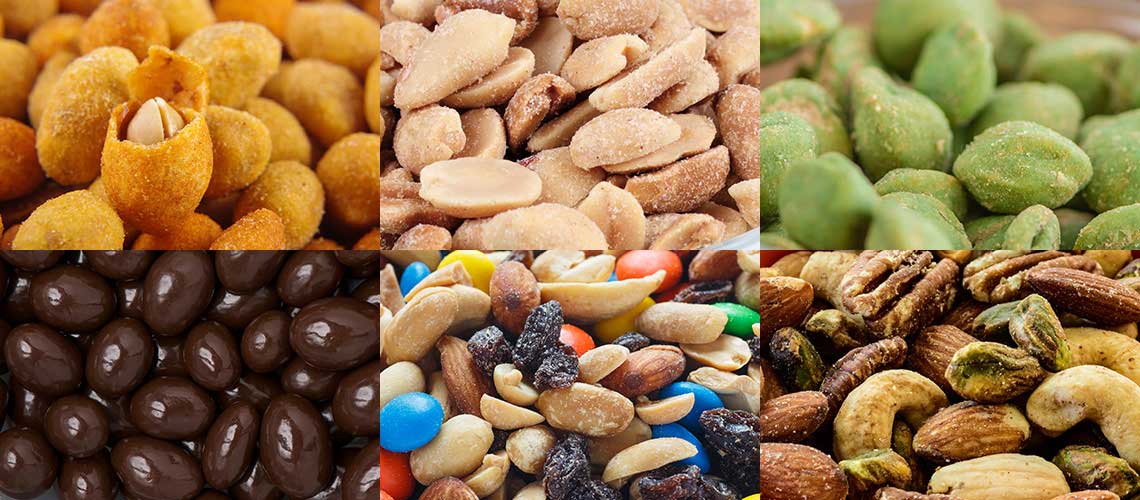
The nut snack processing market uses multiple methods and recipe options to produce unique products with wide ranging flavors. To create a value-added nut snack product, snack processors employ a variety of applications, including:
Oil roasting is a process by which nuts are submerged or covered in hot oil and fried. Roasting accomplishes many tasks, including flavor enhancement, shelf stability (1.0 to 1.5% finished moisture), and destruction of microbes, such as Salmonella. For example, almonds require 2 minutes at 260°F (127°C) to destroy microbes. Basic frying principles can apply to most nut varieties (e.g., peanuts, almonds, cashews, pecans, walnuts, brazil nuts, sunflower seeds). Certain nut types, such as macadamias, need special care and handling considering their high cost and fragility. Also, because of their delicate flavor, it is necessary to fry them in high quality oil.
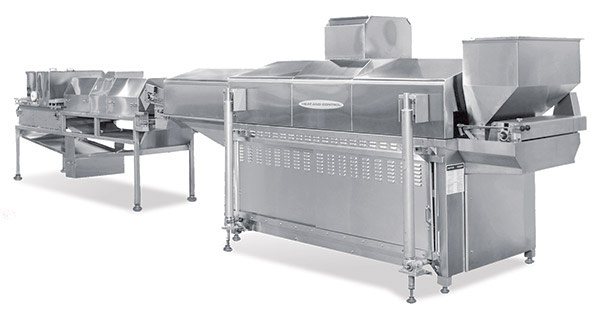
Equipment shown from left to right: RSX Salter, Glazing Oil Applicator,
Mastermatic Cooler, Mastermatic Nut Roaster, Nut Infeed Hopper
Frying time and temperatures are critical due to the very short time between adequately cooked and burnt. Customized conveyors are designed to help meter product for consistent roasting through the fryer. This varies depending on the nut variety, and attributes should be determined by testing and experience. Product feed to the roaster is critical to achieve a consistent production rate and uniform product depth. Moreover, it is essential to remove any debris before nuts enter the roaster.
Oil type or blend is an important factor for flavor development and is often a significant part of a brand’s secret recipe. Typical oils include canola, safflower, sunflower, peanut, and various hydrogenated blends. If oil solidifies at room temperature, all piping and tanks (especially low to the ground) must be heat traced, using steam or electricity.
Various processes can take place prior to oil roasting that impart a specific mouth feel, taste, and flavor experience (e.g., brine soaking, coating, drying). If nuts are dry roasted prior to coating, frying will be required to cook the coating only.
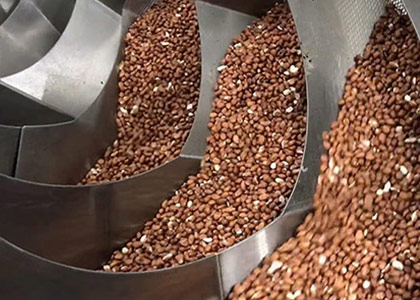 Dry Roasting
Dry RoastingA dry roast involves processing by means of hot air, and some snack processors use this method to reduce oil content. Entry-level processors use forced air or semi-industrial type convection ovens with nuts in a single layer, stirring regularly to avoid surface burning. Large volumes are typically roasted in custom design drying ovens and include rotary type dryer/roasters. Certain types of rotary dryer/roasters are designed to lift, to fold, and to expose each product piece to fan-forced heated air thus fluidizing the product bed so product is more evenly roasted and dried. This process is beneficial not only for traditional roasted nut products but also for honey-roasted and dough-coated Japanese- or Holland-style nuts. Independent heating zones allow for precise temperature control throughout the process.
This is where the uniqueness of a snack nuts comes into play and where the product can be positioned as a premium snack. Seasoning nuts allows snack processors to add sweet or savory dry ingredients or a water-/oil-based seasoning emulsion to traditional nut products, as well as dough-coated products. Exotic flavor recipes are used as a means of achieving premium price points or appealing to specific taste profiles in markets globally.
The application of glazing oil, water, salt, spice-based seasonings, sugar, dough, chocolate, yogurt, and batters gives personality to the product. Flavor and texture can be added to the base formulation with frying and drying temperatures enhancing flavor profiles. In addition, color can be added to the base flavor mix to improve visual appeal.
Coating and seasoning application can be done in the process area (i.e., in-kitchen), in the packaging room, or on the belt along the line. Process area seasoning can occur directly after the dry roaster or after the cooling process and before transferring into the packaging room. On-machine seasoning (OMS) occurs in the packaging room, directly before the product goes into the weigher and bag maker.
Dry season application of nuts can be complex as often a tack solution (stick) is required for adhesion of the dry seasoning. In many cases, this requires an oil- or a water-based solution, such as a gum Arabic or maltodextrin applications, before the dry application. Furthermore, the roaster type (oil or dry) is a crucial factor. For example, if the nut is dry roasted, a two-stage oil plus dry or salt application is required to achieve adhesion. For a coating such as a Tamari or brine, a water application plus dry is applied after a dry roaster with the cooler system turned off. If an oil roaster is used, then dry seasoning or salting can be used after the fryer. Consultation with seasoning system experts and often testing is necessary to decide the best adhesion and coverage of dry seasoning application.
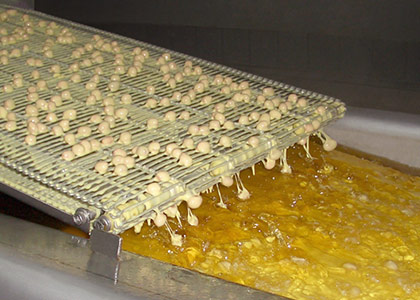 Batter Coating
Batter CoatingAn example of batter coating is seen in the Indian snack category, Namkeen. Often peanuts are coated with batter made from Besan flour (gram or chickpea flour) and spices before going into an oil roaster (fryer). For this market, the key objective is to maintain the traditional taste and texture of a handmade product in a continuous system. A specially designed vibratory feeder singulates the product and feeds it into a curtain of batter. This ensures that the product is presented to the batter curtain in a single layer, thus reducing the risk of getting doubles or married product. The batter curtain has a counter flow which ensures that the product is fully encapsulated before being placed into the fryer for cooking. These features ensure a premium coated product is produced with minimal waste.
Honey coatings, popular in Europe and the Middle East, apply a viscous honey solution that is sprayed into the infeed end of the tumble drum. This is followed by sugar/salt to dry the slurry at the discharge end of the drum. Often, other ingredients are added, such as dried fruit pieces and spices.
A popular coating in the Middle East, this is normally a water-based coating and is done directly after the dry roaster and before a cooler. The heat of the nut evaporates the water in the coating leaving a lightly coated nut. Dry seasoning can be added when using a starch and water combination.
Coatings used in Asia and parts of Latin America are typically quite thick and utilize cracker or dough-based ingredients to achieve a thick enrobing type of coating on the nut. In some cases, raw skin on peanuts is used where the skin imparts a unique taste and helps the coating adhere better to the nut, as opposed to a “naked” nut.
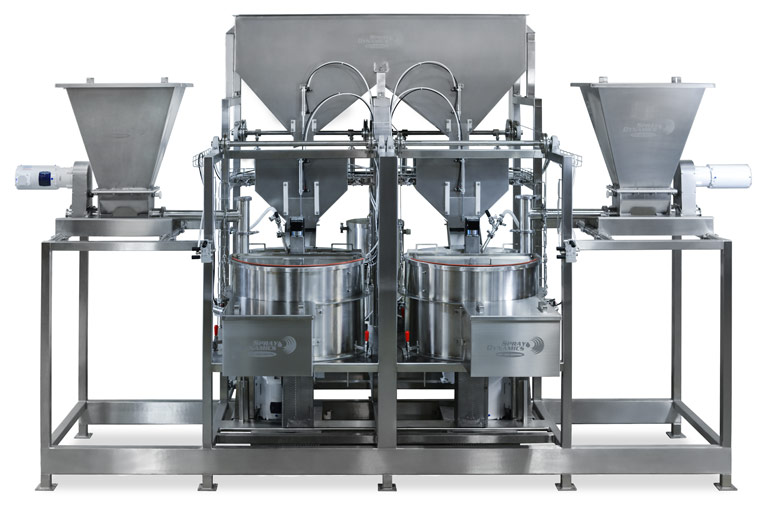
Blending different kinds of nuts, or nuts with fruits, and candy provides another opportunity to create innovative products like the popular trail mix. Accurate blending systems can mix multiple products into proportionally even blends that do not stratify or separate before they reach the packaging station.
Accuracy, ease of use, and overall value are the keys to an efficient blending system. There are three kinds of blending system design:
In all cases, the key is to maintain the blend so that the consumer will get the variety and proportions they expect. The use of FastBack horizontal motion conveyors with specially designed pans prevents segregation of blended and varied density products while conveying gently and quietly.
Ease of use is important and can be guaranteed with intuitive touch screen operation that allows operators to choose a recipe, to verify the correct materials are loaded, and to push start. The system will automatically disperse the correct amount of recipe ingredients, preload the system, and blend the mixture, ensuring even the first production is right on target.
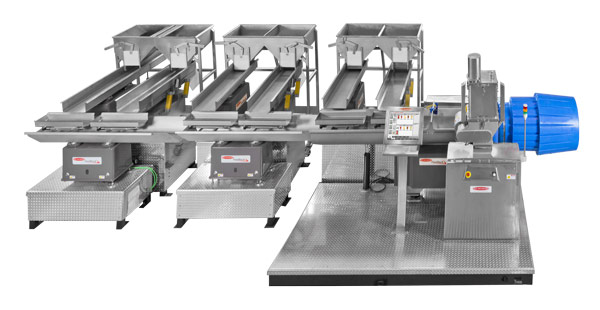
Modular designs that include integrated seasoning application and
tumble drum mixing offer improved blend and OMS capability
With a myriad of methods and recipe options available and reliable, automated processes becoming more accurate, snack processors are only limited by their imaginations to create the nut snack industry’s next product success.